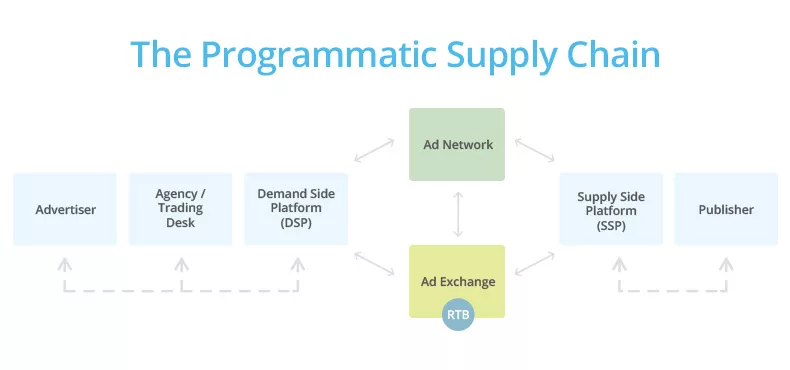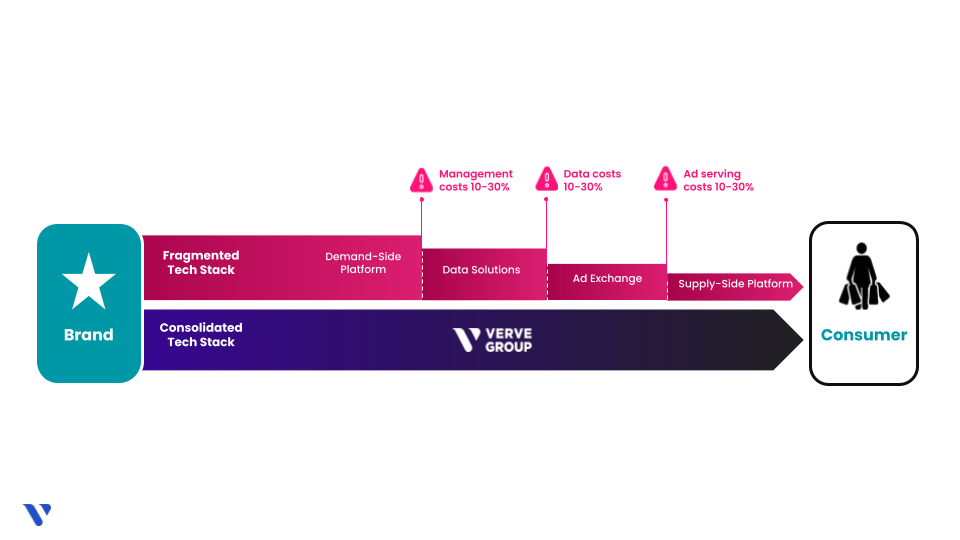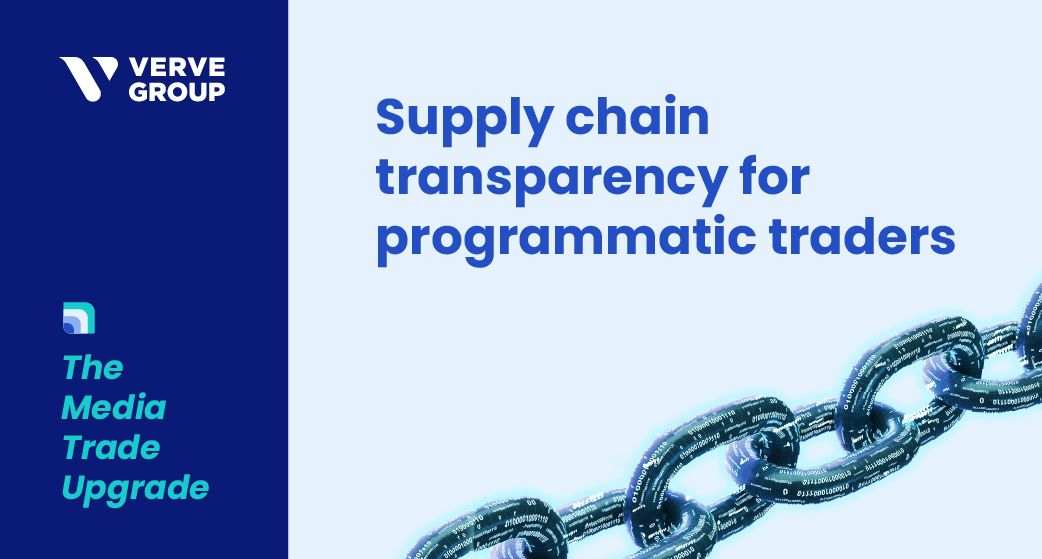The Media Trade Upgrade is back! This series decodes complex programmatic topics into bite-sized blogs to help you succeed, whether you’re an in-house media buyer or part of an agency team. In this post, we’ll do a (very brief) refresher on the definition of the programmatic supply chain and its role in advertising. We’ll then cover exactly what programmatic media traders need to know about how transparency impacts day-to-day media buying and optimizing campaigns.
Estimated reading time: 6 minutes
Quick recap: What is the programmatic advertising supply chain?
The programmatic advertising supply chain is a data-driven, streamlined process with many “links” serving different roles.

In its simplest form, the programmatic supply chain works like this: publishers offer ad space, DSPs let advertisers to bid for ads, DMPs provide audience insights for targeting, ad exchanges facilitate the transaction, and ad networks pool inventory for broad reach.
Ideally, each link in the chain adds up to deliver precise, efficient campaigns.
Defining supply chain transparency in programmatic
In the context of programmatic advertising, “supply chain transparency” refers to clear and open knowledge of the entire ad delivery process. This includes understanding where your ads are placed, who sees them, and how much you pay for each interaction.
Why does supply chain transparency matter in programmatic advertising?
- Trust and control. Transparency builds trust between advertisers, publishers, and consumers. When there’s clarity about where ads are appearing and who’s seeing them, it creates a sense of accountability and reliability. Transparency builds trust in the buying process and ensures that media buyers have more control over the ads placed. Media buyers can ensure ads appear on brand-safe websites and avoid ad misplacement, which can harm a brand’s image.
- Fraud prevention. A transparent supply chain can help identify fraudulent activities such as low viewability, adding a layer of security for your ad dollar investments.
- Supply path optimization. Visibility into the programmatic supply chain means you can make better-informed decisions, optimize your campaigns, and ultimately improve ROI/ROAS. Transparency allows the buyers to keep a better eye on the ad placements and turn campaign insights into optimizations. Programmatic traders can also avoid unnecessary links in the supply chain to make faster, more cost-efficient, and environmentally responsible media buys.
Supply chain transparency for programmatic traders
If you’re a programmatic media trader, understanding supply chain transparency can help you:
- Make smarter media-buying decisions.
- Increase ROI of ad spend.
- Communicate your rationale to account execs and clients in QBRs.
Media traders should also know about transparency’s impact on other factors like brand safety, inventory, fees, and choosing partners.
Brand safety
Transparency enhances brand safety by enabling media buyers to monitor and control the context of where their ads appear. It helps you avoid placing ads near inappropriate or controversial content, reducing the risk of damaging brand image or reputation. Transparent supply chains let media buyers see the ad placement before launch, blacklist specific sites or categories, and set brand safety preferences.
Understanding inventory
Transparency in programmatic advertising helps media buyers clearly understand the costs involved in media buying by uncovering inventory options and pricing. Increased visibility into the vast menu of ad inventory might inspire you to buy media in placements you hadn’t previously considered. With a deeper understanding of inventory sources, media buyers can target the right audience and optimize their campaigns to hit KPIs.
Managing ad fees
A nontransparent programmatic supply chain makes it hard to know how much budget actually secures the ad space.
Knowledge is power in media buying and trading: The more you know, the better your campaigns.

(Call us biased, but bear with us. Verve’s consolidated tech stack serves the entire advertising supply chain, meaning we can pass on savings to all stakeholders. Let us know if you’re interested in learning more!)
Vendor relationships
When vendors like DSPs and ad exchanges share their processes, they can gain media buyers’ trust and confidence and earn lasting partnerships. Media buyers can use this transparency to select best-fit, trustworthy vendors to ensure maximum ROI on their ad spend. Healthy, long-term vendor relationships can create opportunities to negotiate better prices for ad placements, potentially improving budgets.
Follow the money: Challenges in programmatic transparency
Reaching supply chain transparency isn’t easy, due to the complex programmatic ecosystem and evolving data privacy regulations. But with ongoing industry efforts, such as the ISBA Programmatic Supply Chain Transparency Study, the advertising world is fostering transparency and accountability.
The 2020 ISBA Programmatic Supply Chain Transparency Study revealed significant opacity in programmatic advertising, with unattributable costs (“unknown delta”) and variable fees. The ISBA (Incorporated Society of British Advertisers) is part of the World Federation of Advertisers and partnered with the AOP (Association of Online Publishers) to commission an independent study by PwC. The study analyzed 2.2 billion lines of data and 267 million ad impressions over 15 months. The shocking results proved to be an important wakeup call for the programmatic industry, inspiring stakeholders to address five main challenges.
- “Chicken and egg” permissioning. Despite the funny name, this is a serious lack of clarity over data-sharing between parties, and who needs to grant or request permissions.
- Supply chain complexity. The 15 advertisers in the study reached 12 publishers — but used almost 300 unique supply chains to get from Point A to Point B.
- Access delays. Many supply chain intermediaries weren’t clear about permissions, creating major delays in data access.
- Data formatting and fidelity. Different links in the supply chain stored and formatted data in many ways, leading to issues with data matching.
- Inflexible data retrieval. DSPs captured impression data differently than counterparts on the sell side of the supply chain. This meant campaign-level impression matching was difficult (or impossible).
A brighter future for the programmatic supply chain
A follow-up study published in 2023 showed promising improvements in programmatic supply chain transparency. The ISBA’s 2022 Programmatic Supply Chain Transparency Study highlighted significant advancements in transparency and data quality.
- Unattributable programmatic ad spending dropped from 15% to 3%, signifying a clearer understanding of costs.
- Match rates also improved dramatically (jumping from 12% to 58%), indicating improved data accuracy.
Parting thoughts
That’s it for now from The Media Trade Upgrade! We hope this guide to programmatic supply chain transparency was helpful, especially if you’re a media buyer or campaign manager. Questions/comments? Shoot us an email at moc.e1722064179vrev@1722064179gnite1722064179kram1722064179.
Want to keep digging into trust, transparency, SPO, data privacy (and more)? Here are a few recommendations:
- Triple Threat: Ad tech’s need for trust and transparency
- Breaking Down Supply Path Optimization With Tim Koschella
- The Media Trade Upgrade: What Programmatic Traders Need to Know About Data Privacy Regulations
Sources: ANA Programmatic Media Supply Chain Transparency, ISBA Programmatic Supply Chain Transparency Study, Marketing Week





